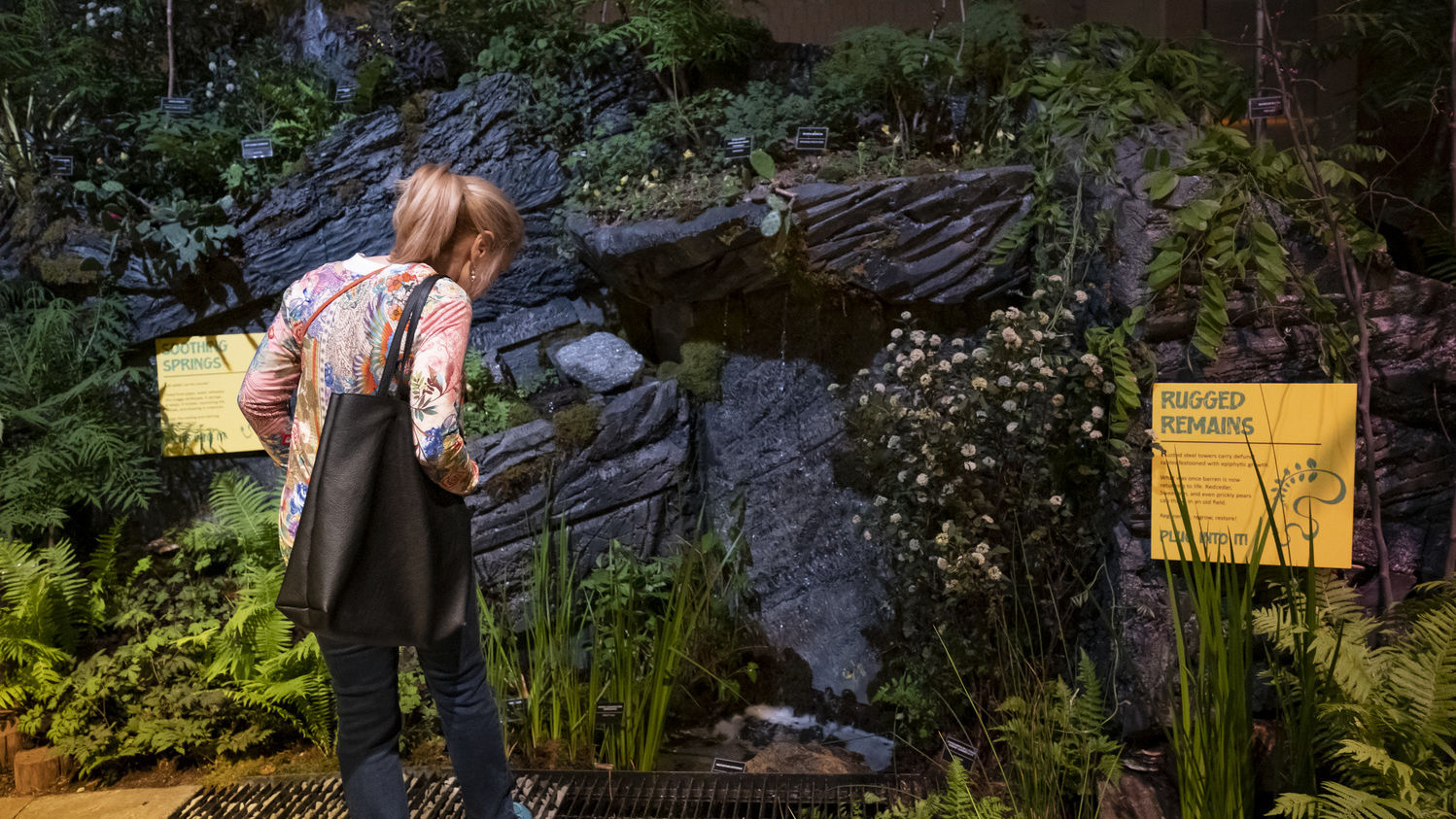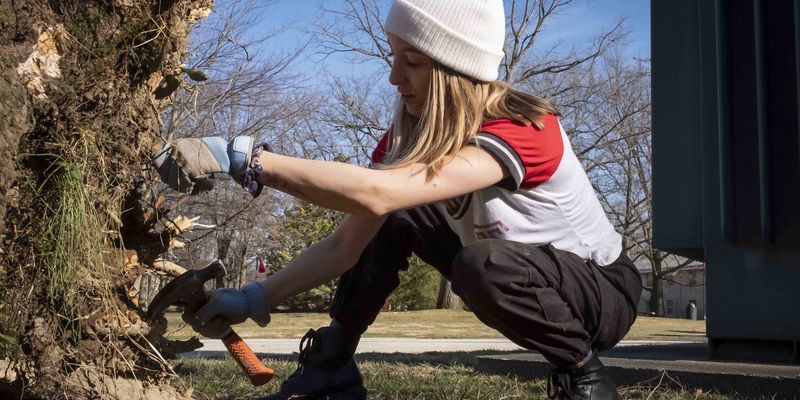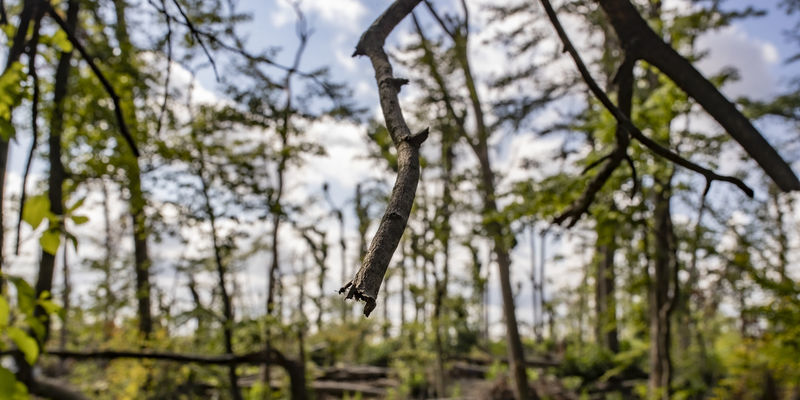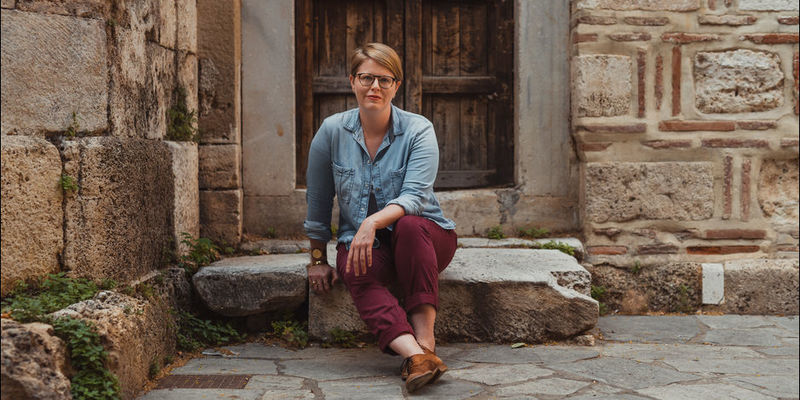Temple University plugs into “The Power of Nature” for the Philadelphia Flower Show
Students from Tyler School of Art and Architecture's Landscape Architecture and Horticulture program will present The Power of Nature—Plug Into It at the Philadelphia Flower Show from March 4 through March 12.

They dot the landscape throughout the country and well beyond. Old electrical towers. Abandoned power stations. Monuments to changing technology, changing populations, changing needs.
Over time, nature will take back those sites, absorbing them once more into the natural environment. That is the power of nature, constantly changing, always recreating.
Tyler School of Art and Architecture landscape architecture and horticulture students will harness nature’s constant adaptability when they present The Power of Nature—Plug Into It at the Pennsylvania Horticultural Society’s (PHS) Philadelphia Flower Show, which will return to the Pennsylvania Convention Center from March 4 to March 12.
The exhibit has won six top honors, including the PHS Gold Medal, which is awarded to “a major exhibit that receives 95 or more points out of 100 in the criteria of design, horticulture, plantsmanship and educational value,” as well as the Alfred M. Campbell Memorial Trophy, the PHS Gardening for the Greater Good Award, the Bulkley Medal of the Garden Club of America, the Pennsylvania Landscape Nursery Association Trophy, and the Special Achievement Award of The Garden Club Federation of Pennsylvania.
“In this exhibit, we are exploring the outdated and abandoned relics of power distribution systems as they are reclaimed by nature,” said Landscape Architecture and Horticulture Associate Professor Michael LoFurno, who is guiding the students on the project with adjunct professor and Temple landscape architecture program alumnus Zoe Boothe-Jarrett. “Over the last century, electric power distribution lines have been cut through the landscape without regard for topography, vegetation or waterways. New green energy solutions provide many opportunities for change. Abandoning these outdated relics of our electrical past provides the opportunity for regeneration, regrowth and restoration.”
The PHS's theme for the 2023 Philadelphia Flower Show is “‘The Garden Electric!,’ that spark of joy that comes while giving or receiving flowers.”
“When we were thinking about the overall design of the exhibit and the goals of the project, we looked at a lot of different landscapes that inspired us as a class. A consistent theme was post-industrial reclaimed landscapes, how nature takes over an area that was created for human use,” said junior landscape architecture student Danny Logue, who was also part of the team of arboretum student gardeners who presented Queer Roots of Nature: A Natural History of LGBTQ Botany at the 2022 Flower Show. “Our exhibit showcases the transition from a more naturalized, wild, formerly decayed site into what can be rebuilt out of those ruins. The woodland area, for example, is much more naturalized, while the section that my team is working on is a little more formalized using reclaimed materials to create something new and beautiful.”
According to LoFurno, PHS asked each of the academic educational category entrants to select a color as “a sort of under theme for our exhibits—red, yellow, blue and all the way through the spectrum.”
“We chose yellow because at this time of year it is a very bright color that evokes spring—people want to see sunshine and feel its warmth. Yellow is also evocative of electricity and electrical systems,” said LoFurno, who is helping to oversee his 14th Temple exhibit this year. “We’re going to be highlighting yellow in various ways with a lot of spring blooming flowers in addition to lighting elements that are a central feature of the exhibit.”
From a plant perspective, “there are really two concepts that are being explored,” said Benjamin Snyder, manager of the Tyler School of Art and Architecture Greenhouse Education and Research Complex at Temple Ambler.
“We’re looking at early succession—the process by which the mix of species and habitat in an area changes over time. Since we are representing a power plant that is being reclaimed by nature, we’re using plants that you would find in early successional forests,” he said. “Since our concept has yellow incorporated into its theme, when we went to pick plants, we were looking for things that both had yellow flowers as well as yellow foliage. That includes things like daffodils and well as heucheras and other yellow foliage plants.”
From design to reality
Temple University Ambler has a long and rich history with the Philadelphia Flower Show dating back to 1916 and Temple Ambler's predecessor, the Pennsylvania School of Horticulture for Women (PHSW). The Tyler School of Art and Architecture's landscape architecture and horticulture programs, Temple University Ambler and the Ambler Arboretum have taken home dozens of awards throughout that history.
According to LoFurno, students in the Landscape Architecture Junior Design-Build Studio have been working for several months in four teams on different aspects of the 2023 exhibit.
“The first is the emergent woodland, which focuses on the idea that an abandoned power station or electrical artifacts are being reclaimed by nature. Some things are left standing— telephone poles and electrical towers—but they are being taken over by vines, and pioneer species are coming in,” he said. “The second area, the precipice, is going to be the tallest part of the exhibit. We always try to have a focal area that’s very tall and can be seen from across the show beckoning people to the exhibit. The precipice is reminiscent of the Wissahickon Valley in terms of what we’re trying to represent and will include some water elements.”
The timbered path that runs through the exhibit—constructed from mature trees felled by the tornado that struck Temple Ambler in 2021—will provide a transitional space between different aspects of the exhibit, LoFurno said.
“We are once again creating a walkthrough exhibit so that people have a chance to get up close and smell the flowers, feel the water and be immersed in the exhibit,” he said. “The final area of the exhibit includes the transformative towers. Those are relic steel towers that we are going to embellish in various ways—it’s a more geometric, orthogonal part of the design.”
Ziyu “Chris” Wu, a junior landscape architecture major, worked with the pathway team during the fall semester and is currently working with the student team working on the exhibit façade.
“With the pathway, one side of the exhibit emphasizes nature, while the other side emphasizes architecture—we chose different materials to correspond with those themes. This semester, the team I’m working with is focusing on the façade, which includes growing plants and water features,” he said. “For me, I’ve taken some inspiration from the designs of Temple’s previous exhibits. I hope visitors this year come into the exhibit, see the different themes we are presenting, experience the different textures and diversity in the vegetation, and the sound and feel of the water features. Hopefully there are aspects of the exhibit that inspire them.”
According to Lauren Kobistek, a junior landscape architecture major, when working on the design students were initially given a preliminary concept plan to work from, “which has changed a lot since we first started working on the design in the fall.”
“It was our job to refine it and come up with construction drawings and the general theme of what we’d be presenting. We’re using materials from past Temple Flower Show exhibits—we’re trying to be sustainable in that way,” she said. “We had to create the construction drawings and those plans are continuing to evolve—they change as we build and figure out what is working and what isn’t. It’s a learning process that is really coming together collaboratively.”
In conceiving of the final design for the exhibit, the students, “took large concepts and broke them down into elements that could be included within the exhibit,” said Boothe-Jarrett, who has personal experience working collaboratively to make Temple’s Flower Show visions a reality having previously worked as a landscape architecture major on the 2014 entry, Tamanend's Track: The Path to a Portrayal of the Past.
“Each of those elements tells an important story and contributes to the larger themes of the exhibit and the show in general. One of the major things I personally got out of building a Flower Show exhibit as a student was working as a team with my fellow classmates. The construction knowledge was also very valuable in the professional world—for some of the students this is their first time working with these kinds of tools,” he said. “It’s very rewarding to see something that you’ve worked on come to fruition in such a short period of time. Now to be part of that again and help our current students go through that process, that experience has been wonderful.”
According to Logue, one of the primary aspects that drew them to Temple’s Landscape Architecture program “was that there was an emphasis on real-world experience, having projects like the Flower Show and other classes where we’ve designed for real locations.”
“I wanted that hands-on experience so I could gain experience matching design aspirations with physical reality,” Logue said. “Every time I go to the Flower Show, I am always drawn to new ideas, things that I’ve never seen before. In helping to design this exhibit, I wanted to create something that I hadn’t seen at the Flower Show previously.”
In the greenhouse
The 2023 exhibit continues a long tradition within the landscape architecture and horticulture programs of interdisciplinary and hands-on learning experiences. Temple is one of only a handful of exhibitors that forces its own plants for their exhibits. At Temple University Ambler each year, Temple horticulture staff and students use various techniques to "trick" the plants into thinking that late February/early March is a perfect time to put their best blooming face forward for the signature event's 250,000 guests.
According to Snyder, the four main aspects that go into forcing a plant to bloom out of season are length of cold treatment, heat, light and humidity.
"We need to trick plants into thinking that winter is over and spring is here. To do that, they need to have an early winter," said Snyder, a Tyler horticulture program alumnus. "We accomplish this through vernalization. Overall, we are using 65 different species and about 852 individual plants."
According to Ethan Smith, a senior horticulture major who, with landscape architecture sophomore Owen Lambert has been tending to the needs of the Flower Show plants with Snyder, vernalization requires “a lot of moving.”
“When it comes to preparing plants for the Flower Show, a big factor is temperature. We have to do a lot of moving between the freezer outside, the greenhouse, and the hoop house—it takes a great deal of careful attention to the needs of the plants,” he said. “I’ve learned a lot about what it takes to force a plant. Before this, I had learned about various biological processes, but I had never really learned about the processes of how to get a plant to leaf out and flower so quickly. You are essentially planning their growth cycle around a specific date and time.”
Building in a new venue
All of the design/build work for the 2023 exhibit has taken place in the Innovation Studio at Temple Ambler, a dedicated space for collaborative research and study in the Ambler Research and Collaboration Building, the former location of the campus library, which was repurposed following the severe damage caused by the 2021 tornado.
“This new space that we are located in has a great high ceiling and lots of light. It provides a great deal of flexibility in terms of what we’re building—we can get the entire exhibit in one space, which was a challenge in years past,” he said. “The exhibit is about 30 feet by 20 feet by 20 feet. We can work on the structure as it will look at the show and work on making the effects that we want to create here.”
One of Temple’s primary goals at the Philadelphia Flower Show each year “is to educate exhibit visitors,” said Boothe-Jarrett.
“We want to give them knowledge and keep them thinking about what they have seen and experienced long after they’ve left the show,” he said. “We pose questions to our visitors, some of which we touch upon but may not fully answer in the exhibit—why recycle, why reuse things, why are these things important. We want to get the conversation started.”
Kobistek said the experience of working on the Flower Show exhibit “has given me the skills to think more critically about how I am designing and how it is going to work in the real world.”
“As an undergraduate in the field, I think when you are designing you can get carried away with these big concepts and ideas without really thinking about the functionality. When you factor that into the design process it gives you the ability to think about new approaches to solving design problems,” she said. “I am very excited to be a part of the team putting this exhibit together. Beyond the practical knowledge I’ve gained, it’s simply a really interesting and cool thing to be able to say ‘Yes, I built an exhibit for the Philadelphia Flower Show.'”
- Jim Duffy


